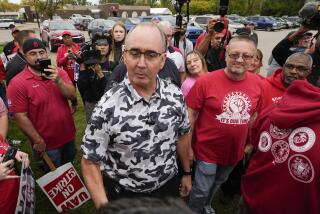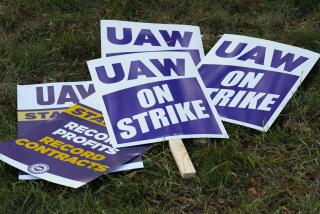Record Profit at GM Masks Weak Domestic Operations
- Share via
DETROIT — General Motors, amid a remarkable financial turnaround, reported record earnings of $4.86 billion for 1988.
Yet GM’s huge profit--the most money ever made by an auto company anywhere in the world--still could not conceal the persistent weakness of GM’s domestic automotive operations, auto industry analysts pointed out.
With its share of the U.S. car market still falling--down to just over 34% in January--GM earned relatively little from its American car business.
But thanks to tough cost-cutting measures and a strong performance turned in by its overseas operations, GM posted a 37% earnings gain over 1987. Additionally, in the fourth quarter, GM said it earned $1.39 billion, up 67.3% from the same period in 1987.
GM Chairman Roger B. Smith said in an interview that the record profits show that his most controversial actions of recent years--the huge investments in new plants and equipment, GM’s big acquisitions and its massive reorganization that briefly brought internal turmoil--are all starting to pay off.
“I think this comes at the end of a lot of hard work by a lot of people,” Smith said.
The target of intense criticism from Wall Street and the press for spending far too much on new technology while allowing GM’s position in the car market to erode, Smith took quiet satisfaction Tuesday in the bottom-line results.
“I don’t look at it as me being vindicated, I look at it as doing my job,” Smith said.
“But you’ve got to wonder now, who they are going to pick on next. . . . If they take every executive who wants to invest in the future out and shoot him, then where would we be?”
Still, analysts don’t see Tuesday’s results as vindication for Smith, since GM’s North American auto operations remain so deeply troubled. In fact, just as GM’s record earnings were coming out, GM on Tuesday also posted a 23% drop in U.S. car sales.
David Healy, automotive analyst for Drexel Burnham Lambert, noted that GM spent $1,000 per car on sales incentives in the fourth quarter of 1988 and still is struggling to stabilize its market share.
“They are improving,” Healy said. “GM’s share decline has been nearly halted; its costs are getting better, and so they had some real tangible improvements. But I don’t see it as being as great as the GM PR machine makes it out.”
Analysts agree that GM’s efforts to increase its market share may be unsuccessful until later this year, when its sleek all-plastic mini-vans and the four-door sedan versions of its new intermediate-sized GM-10 cars--including the all new Chevy Lumina--are introduced.
Biggest Problem
“But those won’t be out for months, and so I think their market share will continue to be under pressure in the first half,” Healy said.
“I think they can maintain this level of profitability in 1989, but the key will be whether they can maintain some stability in their North American car operations,” added Jack Kirnan, automotive analyst with Kidder Peabody.
“GM is doing fine on the truck side, where their share has been rising, but I’m still not sure we’ve seen the bottom on the car side.”
Smith acknowledges that the U.S. car business remains GM’s biggest problem. He even conceded that Ford, which is selling virtually every car in North America that it can build, is likely to report even bigger 1988 profits than did GM, when the No. 2 auto maker releases its earnings Thursday.
“Our biggest challenge has been our North American operations,” Smith said. “‘We’ve got EDS (GM’s computer services subsidiary) going, we’ve got Hughes (GM’s aerospace unit) going, we’ve got overseas going, and we’ve got GMAC (GM’s finance unit) going. Now, we’ve just got to get North America going.
“It’s going to be difficult, but not impossible.”
Despite GM’s continuing domestic slide, Smith is a firm believer that his actions are about to pay off. He notes, for example, that Saturn, GM’s huge project in Tennessee to develop an new line of cars by 1990, is on time and under budget.
“The big payoff (for Smith’s actions of recent years) is still ahead of us,” Smith said. “Where we will be in the mid 1990s with technology from EDS and Hughes will be substantially ahead of the competition.
“And don’t forget, a lot of the things we have done--building new transmission and engine plants, stamping plants--Ford and Chrysler still have to do.”
But does Smith believe that he has erred with some of his more controversial policies?
“No, looking back, the only thing I think we could have done differently was to communicate all of this better to our employees, to let them know where we we’re going.”






